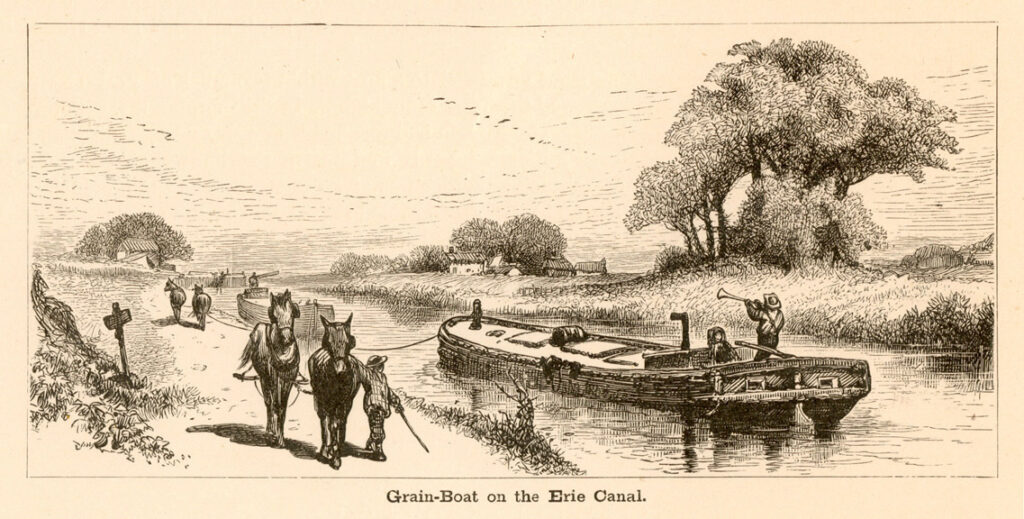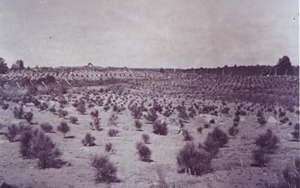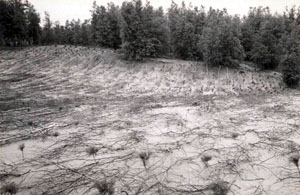Climate Change and Trees, Pt. 1
Climate Change and Trees, Pt. 1
The Tree-conomy
by Erin Trombley
Let’s talk about trees. Trees are not only beautiful to look at, but offer shade to cool hot surfaces and homes, stabilize soil, and offer flood control. Trees produce many of the foods we enjoy, create habitat for wildlife, and are used as material for shelter, furniture, and clothing. Trees naturally sequester carbon, offer privacy, create wind break, absorb sound, enrich soil, and not least of all, produce oxygen. For all the things trees do for us, it’s no wonder nearly 3 million acres of New York’s public land are devoted to managing and protecting them in the form of the Forest Preserve.
Can you imagine New York without its trees?
History of the Tree-conomy
In New York, trees have always been big business. You might say the forest industry is the oldest large enterprise in the state, since substantial harvesting of timber began before the Dutch turned over the land to the English in the late 17th Century and continues to this day. But today’s sustainable forestry practices weren’t always in place. In fact, the rate of tree-cutting up to the 1880s left less than 25% of New York forests standing. Deforestation contributed to significant soil erosion and flooding, which even threatened the viability of the Erie Canal, which was a major commercial corridor across the state, and essential to the existence of settlements in the mid-west.

This prompted the state legislature to create the Adirondack Park in 1892, and the Catskill and Adirondack Forest Preserve in 1885. As a further measure of conservation, the Forest Preserve was given the protection of the state constitution in 1895. By the turn of the 20th Century, it was estimated that without intervention, New York would have no remaining timber within 50 years. To prevent this from happening, the US Division of Forestry started two tree plantations in the Catskills in 1901. The following year the first state nursery in the United States was formed in New York State.
Today’s New York State forest industry, including timber, furniture, wood products, paper and pulp, and some agriculture, generates $13.1 billion in annual direct output and employs over 41,000 people, according to a SUNY Environmental Science and Forestry (SUNY ESF) report. Indirect costs (production supplies and equipment, for example), and induced economic production (the expenditure of household income earned through industry employment) account for another $9.8 billion in forest industry economic impact, for a total of $22.9 billion. Of that total, paper and pulp are responsible for 70%. In the North Country alone, over $1.6 billion of direct financial impact is generated annually, excluding indirect and induced economic activity.
Of the 8.8 million acres of forestland in northern New York, 3.6 million are considered accessible for use. Of those accessible acres, 91% are privately owned, according to a 2015-16 New York State of Opportunity Wood Products Development Council annual report. And while about 4,000,000 tons are harvested annually, more than half again as much is being grown, meaning an increasing surplus of timber is being produced. This ensures that we never again face vast denuded landscapes and the ecological catastrophe that would have followed.
The Other Big North Country Tree-conomy Industry
You might say the Adirondack tourism industry was born in 1869, following the publication of William H. H. Murray’s Adventures in the Wilderness; Or, Camp-Life in the Adirondacks, which painted a picture of the Adirondacks as an Arcadian paradise of unspoiled land, lush trees, and crystal-clear waterways where harried city folk could explore and restore their weary souls. It was not a hard sell for residents of New York City and Boston, where early industrialization meant crowded streets, smoggy air, and some disposable income. They came in droves beginning that year.
Today, tourists contribute $52 billion directly to the New York economy, supporting 6.5% of all jobs statewide, according to a 2021 Tourism Economics report shared by the Regional Office of Sustainable Tourism (ROOST). In the Adirondack region, 18% of employment supports tourism, with visitors spending $1.9 billion across the region. The average expenditure per visitor per visit in 2021 was $1390 and rising. ROOST also reports that approximately 30% of all travelers to Essex and Hamilton counties in 2021 visited in September and October. If that’s true for the entire region, that translates to roughly $570 million spent by travelers just in September and October. Why September-October? Two words: fall foliage.
It’s clear that the fall colors have been attracting visitors to the North Country since before the turn of the last Century, with the term “leaf-peekers” first being published in 1900 and adapted in the 1960s to become “leaf peepers.” Adirondack autumns have traditionally been one of the longest and most spectacular in the nation, so it’s no wonder people flock to the Adirondacks in the fall.

Click here to read part 2, “Effects of Climate on Trees,” about challenges facing Adirondack trees, and what’s being done to save them.
Related
ADK Applauds Updates to Adirondack Park State Land Master Plan
ADK appreciates the Adirondack Park Agency’s (APA) recent updates to the proposed final amendments to […]
Forest Preserve Advocates Applaud Final 2025–26 Budget
May 13, 2025–Albany, NY: Over forty organizations and municipalities advocating for New York’s Forest Preserves […]
Adirondack Conservation Organizations Urge Park Agency to Drop Controversial Motor-Vehicle Plan
February 17, 2025 — Ray Brook, NY — Adirondack conservation organizations today said they were […]
ADK Advocates for the EPF
February 10, 2025—Adirondack Mountain Club (ADK) staff spent the day at the Albany Capitol during […]



